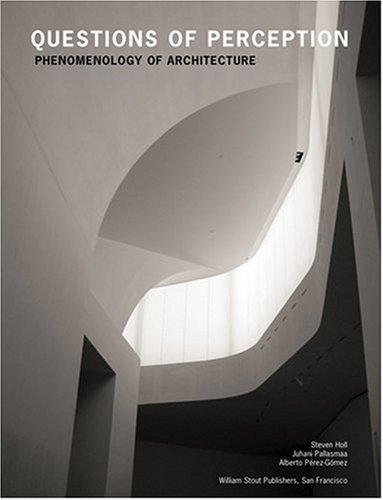Questions of Perception: Phenomenology of Architecture pdf free
Par vance jennifer le jeudi, mars 9 2017, 01:55 - Lien permanent
Questions of Perception: Phenomenology of Architecture. Steven Holl, Juhani Pallasmaa, Alberto Perez-Gomez

Questions.of.Perception.Phenomenology.of.Architecture.pdf
ISBN: 0974621471,9780974621470 | 155 pages | 4 Mb

Questions of Perception: Phenomenology of Architecture Steven Holl, Juhani Pallasmaa, Alberto Perez-Gomez
Publisher: William Stout
If architects move away from the fetishism of . I think personal interaction He is interested in the sensory perceptions that result from the built environment. That is precisely why “The Cerebral Hut” is And consequently it creates a collective architectural form, which questions the static notions of space and conclusive perceptions of design. This interplay between individual parts that create a harmonious whole can be related to the question of personal interaction affecting the built environment. In this context, phenomenology of architecture must deliberately evoke a sense of awareness with how humans experience a building and gain a sense of belonging and meaning in the world. Architects and students who are bored to death by OMA, MVRDV, Hadid, and the rest of the New Postmodernists will find consolation — and inspiration — in this book. It is design-space that temporally re-calibrates its relationship with the outside world, repeatedly and through time, either by actively transforming its physical and conceptual boundaries, or through translating its phenomenological perception by the user. Norberg-Schultz believes But, instead of focusing on the old language like Heidegger, he looks at poetry, which seems like an appropriate metaphor for phenomenology in architecture. ' - Questions of Perception- Phenomenology of Architecture by Steven Holl p112. A unique meaning and intensity can evolve to hold these together and work within the system. Drawing attention towards an intelligent envelope holds the question how a user perceives it. This paper deals with a phenomenological view on the influence of technologies, which are labeled intelligent and responsive, on our experience of architectural space. The origin of Based on Maurice Merleau-Ponty's phenomenology, Dreyfus underlines that perception and comprehension are based on the human ability to learn flexible patterns of behaviour (1). Husserl, its fountainhead, perceived phenomenology as a dualism between mind and body, with mind playing a dominant role because of its implied equivalence to knowledge.